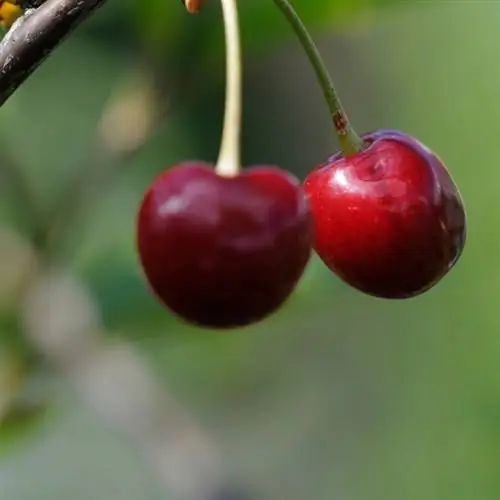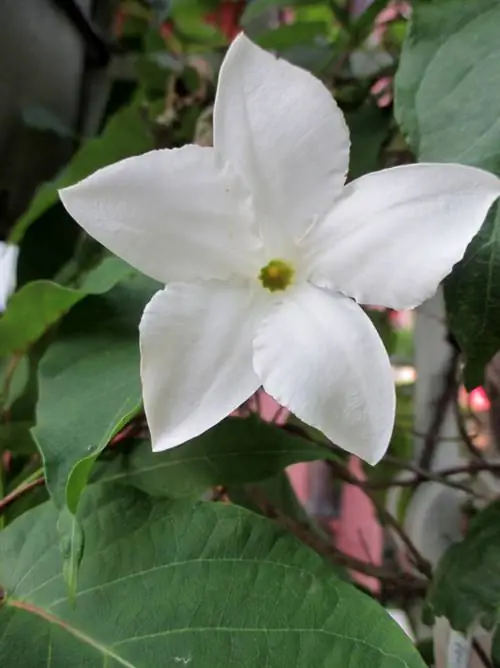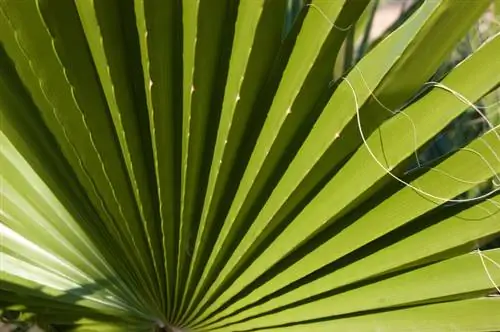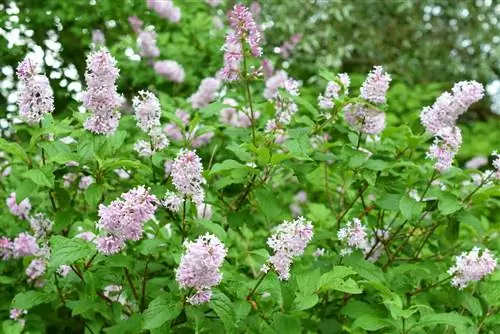- Author admin [email protected].
- Public 2023-12-16 16:46.
- Last modified 2025-06-01 06:02.
Read a commented chamois root profile here with information about growth, flowering time, winter hardiness and five beautiful Doronicum species. Many tips on planting, location and perfect gemswurz care.
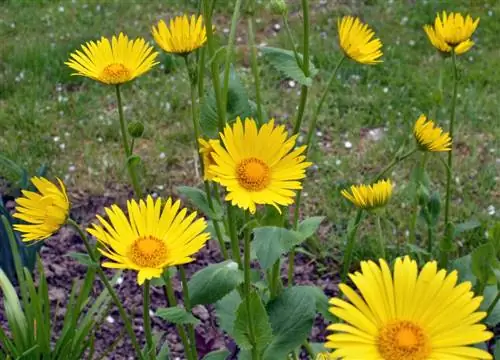
What is gemserk and when does it bloom?
The Gemswurz (Doronicum) is a hardy perennial from the Asteraceae family that is native to Eurasia and North Africa. It grows to heights of 10 to 60 cm and is very popular in gardens and as a cut flower from March to June thanks to its bright yellow, daisy-like flowers.
Profile
- Scientific name: Doronicum
- Genus: Chamois with 35 species
- Family: Daisy family (Asteraceae)
- Occurrence: Europe, Asia, North Africa
- Growth type: Perennial
- Growth height: 10 cm to 60 cm
- Leaf: elliptical, lanceolate, ovate
- Flower: basket-shaped
- Flowering period: March to June
- Toxicity: not poisonous
- Winter hardiness: hardy
- Use: ornamental plant, cut flower, bee pasture
Growth
Gemswort is a popular and grateful perennial from the daisy family (Asteraceae). The natural beauty is native to the temperate regions of Eurasia and North Africa. More than 30 beautiful Doronicum species come together to form the Gämswurzen genus and announce spring everywhere with bright yellow flowers. Key growth data worth knowing explains why hobby gardeners love planting these pretty early bloomers:
- Growth type: perennial, herbaceous perennial.
- Growth habit: clumpy or stoloniferous, basal and/or alternate leaves on strong stems on which daisy-like flowers are enthroned.
- Stem: mostly simple, sometimes slightly branched, downy hairy.
- Height: 10 cm to 60 cm, rarely up to 90 cm high, occasionally up to 150 cm.
- Roots: fleshy rhizomes.
- Gardening interesting facts: hardy, non-toxic, easy to care for, tolerates cutting, bee-friendly.
Various spellings and synonyms are doing the rounds in the trade and in gardening language: gemswurz, chamois root, chamois root or spring daisy.
Bloom
Large, cup-shaped inflorescences characterize the appearance of a gemswort. Gemswurz flowers can be recognized without a doubt by these features:
- Inflorescences: individually (common) or as an umbrella-shaped entire inflorescence (rare).
- Inflorescence cover: hemispherical to bell-shaped, 21 to 30 upright bracts in 2 to 3 rows.
- Single flower: Flower basket with yellow ray florets on the outside and up to 250 tubular flowers on the inside.
- Flower diameter: depending on the species 4 cm to 8 cm.
- Flowering time: March to June or June to August.
Video: Experience the gemswurz flowering time in the Lindow monastery ruins
Leaf
The leaves add decorative fullness to a gemsork perennial. The arrangement and shape vary depending on the species. These are the most important facts:
- Leaf shapes: petiolate or sessile, elliptical, lanceolate, heart-shaped or ovoid, rarely spatulate or violin-shaped.
- Leaf edge: smooth, serrated or notched.
- Leaf area: glabrous, sometimes glandular-hairy.
- Position, arrangement: basal and/or alternate on the upright stem.
- Leaf color: light green
After the first frost, the leaves move in without any autumn color. Doronicum species with basal leaves do not thrive with structured leaf rosettes, as you know from the succulent perennials Houseleek (Sempervivum) or Bitterroot (Lewisia). Rather, the leaves are gathered loosely like a tuft around the distinctive inflorescence shaft.
Species
The genus of chamois gives the creative hobby gardener these garden-suitable species for beds, pots and flower boxes:
| Gemwort species | Dwarf Chamois | Spring Chamois | Creeping Chamois | Large-flowered gemwort | Austrian chamois root |
|---|---|---|---|---|---|
| Botanical name | Doronicum orientale | Doronicum plantagineum | Doronicum pardalianches | Doronicum grandiflorum | Doronicum austriacum |
| Growth height | 10 cm to 40 cm | 50 cm to 80 cm | 50 cm to 100 cm | 10 cm to 40 cm | 30 cm to 150 cm |
| Flowering time | March to June | May to June | May to July | June to August | June to August |
| Speciality | suitable for pots, balcony boxes | beautiful cut flower | forms runners | 6-8 cm large flowers | Largest European Gemsroot |
A look at the flowering period reveals: With a clever combination of different gemsorus species, the perennials add bright yellow splashes of color in the bed and on the balcony from early spring to late summer. Our care tips reveal which simple measures you can use to extend the flowering period by several weeks.
Planting gemwort
The best time to plant Gemswurzen is in late summer and autumn. At this time you can buy ready-to-plant perennials inexpensively from nurseries and garden centers. Balcony gardeners sow spring daisies in pots or flower boxes at the beginning of April. These planting tips explain important details:
Location, soil, substrate
In this location, chamois root thrives undisturbed and blooms:
- Sunny to shady location (the abundance of flowers suffers in partially shaded or shady places).
- Normal, nutrient-rich soil, fresh, moist, permeable, without risk of waterlogging.
Commercial potting soil (€12.00 on Amazon) without peat is suitable as a substrate for pots and boxes. Aggregates such as coconut soil, expanded clay or lava granules optimize structural stability and permeability.
Planting - Tips & Tricks
Gemswurz demonstrates its undemanding nature when it comes to sowing and planting. Simple measures set the course for a long-lasting, flower-rich perennial life:
- Sowing: Sow normal germinators seed deep, keep slightly moist in a bright location.
- Planting in the bed: Dig a planting hole, enrich the excavation with compost, plant water-soaked root balls and water.
- Planting in a container: Create drainage from expanded clay, fill in the substrate up to 3 cm below the edge, form a hollow, insert the water-soaked perennial in the middle, press down the soil and water.
- Planting distance: 25 cm to 35 cm.
Gemsroot is most beautiful in the perennial bed, when combined with other spring bloomers, such as crocus (Crocus), marshmallow (Leucojum vernum), memorial (Omphalodes verna), tulips (Tulipa) and daffodils (Narcissus).
Excursus
Bees would plant gemroot
When the perennial gemswurz blooms in early spring, the table is richly set for bees and bumblebees. The hungry insect queens gratefully feast on the nectar while they devote themselves to the strenuous task of founding a colony. For an area-wide bee pasture of bright yellow flowers, simply sow the seeds directly in the bed from April onwards. At 15° Celsius the seeds germinate within two to three weeks.
Grooming Gemsroot
The chamois root is very easy to care for. The cornerstones of easy care are regular watering, organic fertilization and pruning at the right time. Propagation and winter protection are no headache, even for beginners. Important questions about the best gemswurz care receive a concise answer here:
Pouring
- When to water?: When the surface of the garden soil or potting substrate feels dry (finger test).
- How to water?: Let water from the watering can run directly to the root neck (wet leaves are susceptible to mildew).
- What to water with?: Suitable water qualities are normal tap water, collected rainwater, skimmed pond water.
- What to pay attention to?: Chamois root does not tolerate waterlogging or drought stress.
Fertilize
- When to fertilize the bed?: The best time is in spring or autumn.
- When to fertilize in the planter?: Fertilize spring daisy once a month from March until the end of the flowering period or by eye if there are deficiencies (yellow leaves, few flowers, stunted growth).
- How to fertilize?: Fertilize the bed with compost soil, add liquid flower fertilizer to the water on the balcony.
Cutting
- When to prune?: When the gemswurz no longer blooms for rebloom. Pruning perennials either after the first frost or in late winter.
- How to cut?: After the first flowering period, cut off withered stems and leave the basal leaves. In autumn or late winter, cut back all dead plant parts to 10 cm.
Propagation
For the perennial gemswort, propagation and rejuvenation go hand in hand. The best time is after the flowering period. The following quick guide explains how to do it correctly:
- Cut off wilted inflorescences.
- Push the digging fork under the perennial.
- Lift the root ball out of the ground.
- Cut the rhizome into several parts on a firm surface.
- Cut off dead, old plant parts and compost them.
- Plant sections in the new location, press down the soil and water generously.
Wintering
Gemswurz is hardy down to -28° Celsius. Wet and cold weather shakes up the certified frost hardiness. If the perennial thrives in the planter, it can overwinter outside provided it has winter protection. This is how you overwinter Gämswurzen correctly:
- Overwinter in the bed: Cover the perennial loosely with spruce branches to drain away rain and meltwater.
- Overwinter outside in the pot and box: Cover the container with jute, fleece or potato sack and place it on wood in front of the house wall.
- Overwinter gemseal indoors: Put the pot and flower box in the frost-free winter quarters, do not let the substrate dry out, do not fertilize.
Popular varieties
These premium varieties emerged from the top 5 of the most beautiful, garden-friendly gemswurz species:
- Little Leo: Dwarf chamois root, compact, clumpy, upright, beautiful as an underplant or ground cover, height 10-40 cm.
- Magnificum: lively yellow early bloomer with 8 cm large basket flowers, excellent cut flower, height 40-70 cm.
- Ostrich chamois: golden yellow variety of the stoloniferous species Doronicum pardalianches, ideal for naturalization in the natural garden, flowering period from May to June, height up to 80 cm.
- Finesse: Gemswurz rarity with filigree, fine-rayed flowers from April, height of up to 50 cm at the time of flowering.
FAQ
Is gemstone poisonous?
The gemswurz is friendly to the gardener because there are no toxic ingredients. Thanks to this property, the perennial is perfect for the family garden with pets.
Can the creeping gemsork displace other perennials?
The creeping gemswort can thrive in a partially shaded location with fresh, moist soil. The numerous, strong runners crowd out small early bloomers, such as spring cyclamen (Cyclamen coum), marshmallow (Leucojum vernum) or snowdrops (Galanthus). By combining Doronicum pardalianches with strong-growing hostas (Hosta) or magnificent spars (Astilbe), the problem is solved decoratively and with plenty of flowers.
When is gemsroot flowering time?
Ten to 12 gemswurz species with different flowering times thrive north of the Alps. The dwarf chamois root (Doronicum orientale) is a popular early bloomer from March to June. Yellow ray flowers of the spring chamois (Doronicum plantagineum) decorate the bed and balcony from May to July. Large-flowered gemswort (Doronicum grandiflorum) and Austrian gemswurz (Doronicum austriacum) take things slower and bloom from June to August.
Are Gemswurzen hardy?
Gemswurz species native to Europe are hardy down to -28° Celsius. This frost tolerance suffers a severe setback if the perennial suffers from waterlogging in winter. A cover made of brushwood, straw or pine branches solves the problem. When cultivated in pots and flower boxes, winter hardiness drops to -5° Celsius. In this case, a winter coat on fleece and an insulating wooden base provide relief.
Is gemsroot suitable as a cut flower?
With its taut, upright stems and yellow ray flowers, gemswurz is perfect for cutting in vases. Cut off the prettiest stems when the flower heads have recently unfurled. Please use sharp, disinfected cutting tools. Make the cut above the basal leaves. A positive side effect is that you also stimulate the perennial to produce beautiful subsequent blooms.


